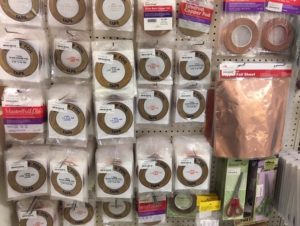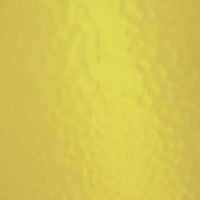
In addition to there being different types of glass which we talked about in Know Your Glass (part 1) there are also different glass manufacturers.
The manufacturers that we stock glass from at Stained Glass Express are:
Armstong—Clarity, richness and depth in art glass! It is difficult to know what is going on with Armstrong. They moved their factory to China many years ago and then came back. However, they no longer had a factory. So we heard it was being manufactured by Wissmach and Kokomo. We see no evidence of that and are not sure where it comes from. However, it is totally beautiful. We try to stock 24 different # but are not always successful as the supply is not consistent.
Bullseye—Is based on Portland, Oregon. I toured they plant a couple of years ago and it is very impressive. They manufacture “colored glass for art and architecture with worldwide distribution and a strong commitment to research, education and promoting glass art”. They really are leaders in comtemporary kiln-glass. Their colors are rich and beautiful.
Kokomo—Kokomo is oldest glass manufacturer. They have been in Kokomo, Indiana for 125 years. They are known worldwide for they hand mixed sheet glass art and colored glass. Even though Tiffany manufactured his own glass he also bought a lot of glass and jewels from Kokomo. Much of Kokomo’s glass was influenced by Mr. Tiffany. One of our favorites.
Firebox—We tired our hand at importing. We have 8 beautiful colors that with a great deal of effort we managed to get here. The price is right and the colors are wonderful. Our of the 10 colors we brought in we had the forethought to bring in two reds and one pink. So while reds and pinks prices have really risen, we have some that remains affordable!
GNA—GNA stands for German New Antique. Unfortunately the color glass is being eliminated and only the clear will remain. We still have some that is our clearance bin and some mirrored that is in the mirror section. However, when it is gone, it is gone. We will continue to carry the clear. It is very beautiful. Fine lines run through it and nothing cuts better!
Spectrum—We stock more spectrum than anything else. We stock stained glass, fusing glass and cabinet glass from Spectrum. It cuts great and they just keep coming out with more and more fun and beautiful products. They give great retailer support. That is where The Score with its info and free patterns come from. I have toured their factory and it is BIG business!
Uroboros—I also toured here. I watched each sheet being handmade! They have been in business since 1973. They have a “broad range of beaufiul and indispensable sheet glass styles for discerning glass artists worldwide.” On glass unloading days we live for the uroboros sheets. Each sheet is different and beautiful.
Van Gogh—We are not certain if Van Gogh is a manufacturer but it sure is different than anything else. What I have read is that it is a glue chip glass, painted with auto paint. It is unique and beautiful. It is great for Mosaics. Not so great in the light.
Wissmach—This is another very old glass manufacturer. They have been manufacturing art glass since 1904. I have toured this plant also. They let us hand pick some glass which they then drop shipped through our distributor. It was a very fun experience. We have a large stock of Wissmach and it is often the pick to match old repairs and church windows. They have also developed a fusible glass with a 90 coe.
Youghiogheny—It is just beautiful glass. Each piece is a work of art. It was founded in 1976 and is now “world-renowned for uncompromising quality”. It is another one that we look forward to on glass unloading day. It is always a treat!
 As you can see, we have three different brands in our store. We just recently switched from Venture Tape to Edco. Venture has been sold twice in the last couple of years and seems to struggle with the consistent great product quality we have always had. We are hoping we will have better luck with Edco. We still have some Venture because Edco did not have a few we wanted. We also stock one Studio Pro in 7/32 black back because it is a good value and we have had good feedback. They do not have a wide variety so that is the only one we have from them.
To explain the variety:
First is width. We were thrilled that Edco comes as wide as ½”. That is great for people who are putting two pieces of glass together. Other sizes: 5/32, 7/32, 5/16, 3/16, ¼. If you want a very thin solder line you use thinner foil. If you need strength or you like a heavier line, use wider foil.
Next is thickness. It is measured in millimeters. It is how thick the foil is. It might be as thin as 1 mil go to 1.25 of 1.5. Venture shows this on the label and by the color of the core the foil is wrapped on.
Next is the backing. There is copper, black and silver. This is important depending on the transparency of the glass and if you are using patina. Let’s say you are making a piece in all clear glass and you plan to not patina it. You should use silver backed foil so the solder line is silver looking on the exterior and because you can see into the glass, it will look silver on the inside. If you use copper, it just jumps out and ruins the piece. If you were using clear and going to patina it black, use black backed. If you are going to patina it copper, use can use the regular copper foil that is copper on the outside and the sticky side.
There is also a foil that is called silvered. It is silver on the outside and the inside. Often used when doing suncatchers and eliminates the need to solder the outer edge.
Then there is new wave which has a scalloped edge. Decorative.
As you can see, we have three different brands in our store. We just recently switched from Venture Tape to Edco. Venture has been sold twice in the last couple of years and seems to struggle with the consistent great product quality we have always had. We are hoping we will have better luck with Edco. We still have some Venture because Edco did not have a few we wanted. We also stock one Studio Pro in 7/32 black back because it is a good value and we have had good feedback. They do not have a wide variety so that is the only one we have from them.
To explain the variety:
First is width. We were thrilled that Edco comes as wide as ½”. That is great for people who are putting two pieces of glass together. Other sizes: 5/32, 7/32, 5/16, 3/16, ¼. If you want a very thin solder line you use thinner foil. If you need strength or you like a heavier line, use wider foil.
Next is thickness. It is measured in millimeters. It is how thick the foil is. It might be as thin as 1 mil go to 1.25 of 1.5. Venture shows this on the label and by the color of the core the foil is wrapped on.
Next is the backing. There is copper, black and silver. This is important depending on the transparency of the glass and if you are using patina. Let’s say you are making a piece in all clear glass and you plan to not patina it. You should use silver backed foil so the solder line is silver looking on the exterior and because you can see into the glass, it will look silver on the inside. If you use copper, it just jumps out and ruins the piece. If you were using clear and going to patina it black, use black backed. If you are going to patina it copper, use can use the regular copper foil that is copper on the outside and the sticky side.
There is also a foil that is called silvered. It is silver on the outside and the inside. Often used when doing suncatchers and eliminates the need to solder the outer edge.
Then there is new wave which has a scalloped edge. Decorative.
 Also sheets of copper so that you can cut for overlays or have it wide. It also has a sticky side.
Also sheets of copper so that you can cut for overlays or have it wide. It also has a sticky side.
 Use this link to see our full line of foils.
https://www.stainedglassexpress.com/metals/copper_-_silver_foil/
Use this link to see our full line of foils.
https://www.stainedglassexpress.com/metals/copper_-_silver_foil/















